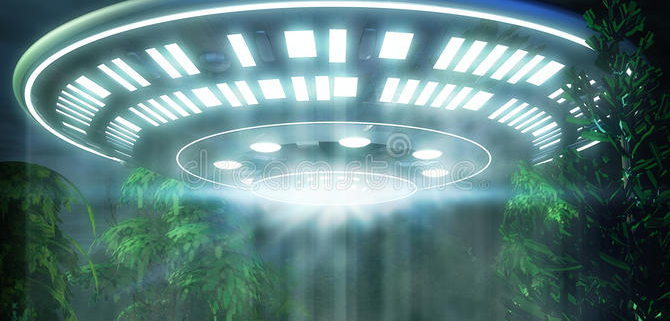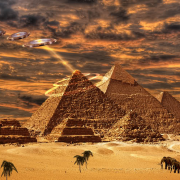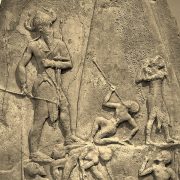The media has played a key role in promoting a new religion for the 21st century. Without the Internet, cable television, and Hollywood, it’s doubtful that the gospel of ET would have spread as far and as fast as it has.
They probably wouldn’t characterize themselves this way, but the presenters on cable TV alien hunter shows are essentially, as Dr. Michael Heiser calls them, televangelists for the ET religion. Ancient Aliens is, incredibly, now in its 18th season on The History Channel.
The History Channel! Do you remember when the History Channel still broadcast programs about history? Sadly, actual history is as popular on cable as it was in high school. So, programmers turned to so-called reality shows, rehashing old cases about UFOs and alien contact, and they found gold in them thar thrills.
We humans love a mystery, and other cable networks have followed History’s lead over the last decade with varying degrees of success. Programs about the paranormal and unexplained are featured on National Geographic, SyFy, Animal Planet, and the Travel Channel. Mystery sells. And nothing is more mysterious than the unexplained lights in the sky and persistent stories of those who claim to have been aboard the ships.
The most popular and influential program on cable catering to the hunger for the ET gospel is undoubtedly Ancient Aliens. It was launched by The History Channel in 2010 as a successor to UFO Hunters, which aired in 2008 and 2009. A number of other programs featuring the UFO phenomenon have come and gone since the turn of the century—UFO Chasers, UFOs Declassified, UFO Files, Hangar 1, and Unsealed: Alien Files to name a few—but Ancient Aliens is plugging along in 2017, a top ten cable show with about 1.2 million adult viewers in its Friday night time slot. By the time you read this, 130 episodes of Ancient Aliens will have delivered the subtle message that the Bible’s account of where humanity came from was incomplete.
In retrospect, the shift from UFOs to “ancient aliens” was a brilliant programming decision. There are only so many ways to make jittery mobile phone videos of blurry lights in the night sky look interesting. Famous cases like Roswell, Kecksburg, and the Phoenix Lights have been analyzed as often as the Kennedy assassination. Without new information on old events, which isn’t likely, or spectacular new cases to investigate, the UFO phenomenon runs out of material quickly—at least as far as what can be turned into entertaining television.
By tying the UFO phenomenon to unsolved mysteries of the past, the producers of Ancient Aliens opened a gold mine of material. Everything from the pyramids to cults and mystery religions were suddenly fair game. Borrowing heavily from the work of Erich von Däniken and Zecharia Sitchin, Ancient Aliens has linked ETIs to ancient Sumer, the cyclopean architecture of the Americas, and Freemasonry.
And, of course, the Bible. This, too, is no accident. Researcher and author Jason Colavito observed that “Ancient Aliens stopped being about space aliens years ago and is now a sort of propaganda arm for New Age religion, which explains why it is so much more interested in the mystery of consciousness than actual evidence for the existence of space aliens. […] Over the years Ancient Aliens has become Theosophy: The Series.”
Exactly right.
The beauty of this approach is that the producers of Ancient Aliens don’t have to prove a thing. A medieval painting, an inscription from the ancient Near East, or an odd-looking prehistoric petroglyph is all they need to build another episode. Host Giorgio Tsoukalos begins so many statements with, “Could it be…,” or, “Is it possible…,” that the show has become a parody of itself.
A classic example is the fascination ancient astronaut believers have with Ezekiel’s wheel:
As I looked, behold, a stormy wind came out of the north, and a great cloud, with brightness around it, and fire flashing forth continually, and in the midst of the fire, as it were gleaming metal. […]
Now as I looked at the living creatures, I saw a wheel on the earth beside the living creatures, one for each of the four of them. As for the appearance of the wheels and their construction: their appearance was like the gleaming of beryl. And the four had the same likeness, their appearance and construction being as it were a wheel within a wheel. When they went, they went in any of their four directions without turning as they went. And their rims were tall and awesome, and the rims of all four were full of eyes all around. And when the living creatures went, the wheels went beside them; and when the living creatures rose from the earth, the wheels rose. Wherever the spirit wanted to go, they went, and the wheels rose along with them, for the spirit of the living creatures was in the wheels. When those went, these went; and when those stood, these stood; and when those rose from the earth, the wheels rose along with them, for the spirit of the living creatures was in the wheels. (Ezekiel 1:4, 15-21, ESV)
The analysis by Tsoukalos? “It reads much more like an encounter with some type of extraterrestrial craft that was misinterpreted as some type of a divine event.”
Well, yeah—unless you’re a Mesopotamian living 2,600 years ago. That type of imagery was common back then. Believe it or not, the subjects of Nebuchadnezzar would have known exactly what they were seeing: a royal throne and its divine guardians.
The UFO interpretation is modern, but it isn’t new. The Spaceships of Ezekiel, a 1974 book by Josef P. Blumrich, capitalized on the growing popularity of von Däniken’s Chariots of the Gods, with the added marketing appeal that Blumrich wrote the book while he was “chief of NASA’s systems layout branch of the program development office at the Marshall Space Flight Center.”
Except that he wasn’t:
One of the reasons so many people have (and still do) think Blumrich’s book is worth referencing is that he claimed (and so his followers are fond of repeating) that he was a NASA engineer. He wasn’t. As Jason Colavito demonstrated a long time ago, documentation exists from the U.S. State Department that shows the State Department could find no evidence that Blumrich was affiliated with NASA. Frankly, it wouldn’t matter if Blumrich was an engineer. His ideas are based on desperate and uninformed misreadings of the biblical text anyway. We know what Ezekiel saw because his descriptions mirror ancient Babylonian iconography that we can look at today because of archaeologists. The imagery is no mystery, nor is its meaning.
So, once again, the uncritical thinkers in the ancient astronaut orbit (and I do mean orbit) were duped by a “researcher” that lied to them. You have to wonder how many times this has to happen before some of these folks wake up. The ancient astronaut theory is primarily supported by industrious but duplicitous researchers offering fraudulent research to an emotionally and psychologically primed audience. It’s actually pretty sad. (Emphasis added.)
So, Blumrich was a fake and Tsoukalos got things backwards. People think Ezekiel saw a UFO because our 21st century worldview misinterprets divine imagery from the 6th century B.C.
Sadly, people who say they take the Bible seriously aren’t any better prepared to understand what the prophet saw than Giorgio Tsoukalos. Those who’ve studied Ezekiel usually haven’t read up on Mesopotamian religious imagery. Evangelists of the ET religion disregard what the ancient Mesopotamians believed because—well, because aliens.
That’s what fuels the continued popularity of the work of the late Zecharia Sitchin. In a nutshell, Sitchin, who passed away in 2010, claimed that Mesopotamian iconography showed the existence of a forgotten planet called Nibiru beyond Neptune. This planet, Sitchin claimed, follows a highly elliptical orbit into the inner solar system about every 3,600 years with catastrophic consequences. Sitchin also equated the Anunnaki, the gods of Sumer, with the biblical Nephilim, and claimed that they arrived on Earth some 450,000 years ago to mine gold in Africa.
Sitchin’s theories are behind much of the Planet X angst that clogs up the Internet. Biblical scholar Dr. Michael S. Heiser, who can actually read Sumerian, has thoroughly debunked Sitchin’s theories, going so far as to post his personal tax returns to show that he wasn’t trying to profit by publicly challenging Sitchin. That hasn’t stopped Sitchinites from continuing to spread the idea that the gods of the ancient world were actually astronauts from outside the solar system.
All manner of ancient mysteries are explained away with, “Well, we don’t know—so it must be aliens.” For example, one of the more convincing stories we’re told about our ancestors is that they couldn’t possibly have moved the stones used to build the pyramids, the temple at Baalbek, or Machu Picchu because our modern cranes can’t lift that kind of weight today. What we’re not told is that between 1768 and 1770, the Russians transported the heaviest stone ever moved by humans, the 1,500-ton Thunder Stone, nearly four miles overland to the center of St. Petersburg without animal or machine power.
Think about that. While the American colonies slowly marched toward a war for independence, four hundred Russians with rope, timber, and a bunch of 6” diameter bronze spheres moved a block of granite that weighed as much as 65 fully-loaded tractor-trailers across six kilometers of dry land in nine months.
The bottom line is this: Just because Giorgio Tsoukalos doesn’t know how people moved big blocks of stone 4,000 years ago, it doesn’t follow that it must have been aliens.
Yet, as factually void as the show is, people still watch Ancient Aliens. And the lack of response from the church to the ancient alien meme isn’t helping. Ignoring the UFO phenomenon hasn’t made it go away. To repeat: A third of Americans believe we’re being visited by ET. Only 10% believe in God as He’s described in the Bible.
Why do we keep coming back to those numbers? Because we’re in the middle of an information war, and pop culture is on the side of the aliens.

Derek Gilbert Bio
Derek P. Gilbert hosts SkyWatchTV, a Christian television program that airs on several national networks, the long-running interview podcast A View from the Bunker, and co-hosts SciFriday, a weekly television program that analyzes science news with his wife, author Sharon K. Gilbert.
Before joining SkyWatchTV in 2015, his secular broadcasting career spanned more than 25 years with stops at radio stations in Philadelphia, Saint Louis, Little Rock, and suburban Chicago.
Derek is a Christian, a husband and a father. He’s been a regular speaker at Bible prophecy conferences in recent years. Derek’s most recent book is The Great Inception: Satan’s PSYOPs from Eden to Armageddon. He has also published the novels The God Conspiracy and Iron Dragons, and he’s a contributing author to the nonfiction anthologies God’s Ghostbusters, Blood on the Altar, I Predict: What 12 Global Experts Believe You Will See by 2025, and When Once We Were a Nation.










Leave a Reply
Want to join the discussion?Feel free to contribute!